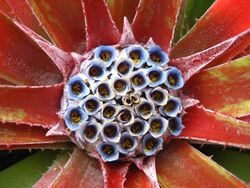Biology:Fascicularia
| Fascicularia | |
|---|---|

| |
| Fascicularia bicolor | |
| Scientific classification Error creating thumbnail: Unable to save thumbnail to destination
| |
| Kingdom: | Plantae |
| Clade: | Tracheophytes |
| Clade: | Angiosperms |
| Clade: | Monocots |
| Clade: | Commelinids |
| Order: | Poales |
| Family: | Bromeliaceae |
| Subfamily: | Bromelioideae |
| Genus: | Fascicularia Mez |
| Species: | F. bicolor
|
| Binomial name | |
| Fascicularia bicolor (Ruiz & Pav.) Mez
| |
| Synonyms[1] | |
| |
Fascicularia is a monotypic genus of flowering plants in the pineapple family Bromeliaceae, subfamily Bromelioideae. The genus name is from the Latin fasciculus (bundle) and arius (pertaining to).[2]
Only one species is known, Fascicularia bicolor. It is endemic to Chile [1] and reportedly naturalized in France and the extreme south and west of Great Britain.[3] In the wild, all Fascicularias are saxicolous (growing on rocks) or epiphytes.[4][5]
It is cultivated in gardens for the dramatic bright crimson colour of its leaves contrasting with the blue inflorescence.[6]
The edible fruits are similar to those of the species Greigia sphacelata, but smaller; They are consumed in the same way as these.[7]
Subspecies
Two subspecies are recognized:
- Fascicularia bicolor subsp. bicolor
- Fascicularia bicolor subsp. canaliculata E.C.Nelson & Zizka
See also
References
- ↑ 1.0 1.1 Kew World Checklist of Selected Plant Families
- ↑ "Bromeliad Info - Genera Etymology". http://www.bsi.org/brom_info/genera.html.
- ↑ "Fascicularia distribution map". BSBI Maps. https://bsbi.org/maps?taxonid=2cd4p9h.3hkxg0.
- ↑ Zizka, G; Horres, R; Nelson, C; Weising, K (1999). "Revision of the genus Fascicularia Mez (Bromeliaceae)". Botanical Journal of the Linnean Society 129 (4): 315–332. doi:10.1111/j.1095-8339.1999.tb00507.x. https://academic.oup.com/botlinnean/article/129/4/315/2557320. Retrieved 30 May 2022.
- ↑ Ortega-Solis, G; Díaz, I; Mellado-Mansilla, D; Moreno-González, R; Godoy, J; Samaniego, H (2020). "The importance of tree species and size for the epiphytic bromeliad Fascicularia bicolor in a South-American temperate rainforest (Chile)". IForest - Biogeosciences and Forestry 13 (2): 92–97. doi:10.3832/ifor2710-013. http://www.sisef.it/iforest/contents/?id=ifor2710-013. Retrieved 30 May 2022.
- ↑ "Fascicularia bicolor, Crimson bromeliad". Royal Horticultural Society. https://www.rhs.org.uk/Plants/7145/Fascicularia-bicolor/Details.
- ↑ Pfanzelt, Simon; García, Carolina; Marticorena, Alicia (2013). "Notes on the Chilean geographic distribution of several vascular plant species". Check List 9 (4): 832–837. https://public.pensoft.net/items/?p=7TVeXpoqfNYT89tyrm3ifrTeG9Wv8P676JSQp%2FH2pj9hhtoybol4GF7LEbj3fxHT5Fo8esHsttgAZJlgYxTDbAHCHfwWCPk5a45KhiTLFAvASBIF%2FwVyLbjF5HKmbQ%3D%3D&n=gTJLSd4CdNEGg8l0u3Docbj1T4Dr7LmW4p7g5qjy7Sk%3D. Retrieved 4 June 2023.
External links
Wikidata ☰ Q2712605 entry
de:Fascicularia bicolor
 |

